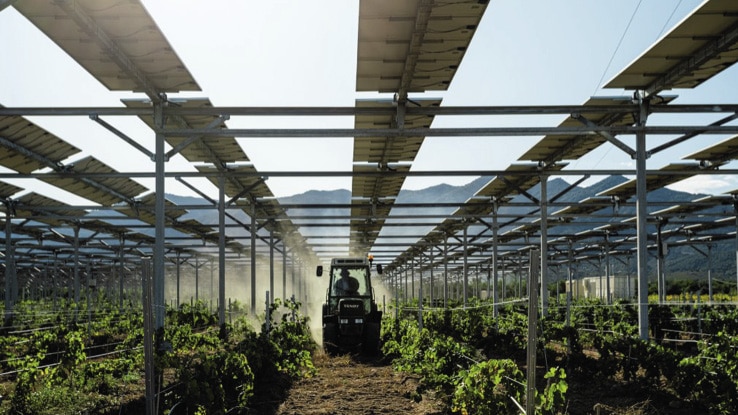One of the central benefits of integrating solar PV and agriculture is that it enables the dual use of land. Farmers and solar do not need to compete for space, but in fact can mutually improve the other’s function. The European Union has a promising innovation for realizing its Common Agricultural Policy (CAP), to support farmers and sustainable rural development, while simultaneously furthering the European Green Deal decarbonization targets.
The innovative component of agrivoltaics installations often leads to higher levelized costs of electricity (LCOEs) than traditional PV installations. Regulatory frameworks should therefore support the development of agrivoltaics through targeted support schemes, until such systems reach price parity with traditional PV installations. These support schemes should include specific energy tenders for large-scale projects, and agrisolar feed-in tariffs, or grant schemes for farmers looking to deploy smaller-scale installations.
Existing subsidies
So far, France has spearheaded developments in Europe with the implementation of an agrisolar financial support scheme in 2017. The Piolenc Vineyard and Nidolères Estate are two sites that successfully employ dynamic agrivoltaics. Both of these installations feature smart-response mechanisms that adjust the orientation of solar panels according to the specific needs of crops at any given time. The installations protect the crops by modifying the climate surrounding them, all while producing clean, renewable, and cost-effective energy.
In 2019, Sun’R deployed a PV system over a Grenache Noir vineyard planted in 2001 in Piolenc, in southeastern France. Agronomic monitoring carried out by the chamber of agriculture of Vaucluse and INRAE, the National Research Institute for Agriculture, Food and the Environment, under the framework of the “Sun’Agri3” R&D program has shown that the installation has reduced the need for irrigation and increased the growth period for the grapes by two weeks. This resulted in a 20% increase in grape weight, a 13% increase in anthocyanin content, and a 15% increase in acidity.
These positive results are now being replicated on a larger scale, for example in the Nidolères Estate. In 2018, 4.5 hectares of a new vineyard were planted close to Perpignan, in southwestern France, with dynamic agrivoltaics. Having saved water, time, and money, the first harvest of these grapes is expected this year.
Another successful application is the 2 MW Bellegarde project developed by Akuo in 2015. The installation combines PV shading structures with the farming of organic apricots, as well as beekeeping. Project planning included an agronomic analysis that led the PV structure to be specifically adapted to the plot of land and to the needs of the apricots that were being cultivated.
The variety of apricot was in fact carefully selected to ensure that it was adapted to an agrivoltaics system, leading to improved yields. The shading structures simultaneously protected the apricots from weather hazards, pests and excessive sunlight, all while allowing enough light through for optimal growth. The project also resulted in a 70% water saving compared to a classic apricot farm.
Around the world, approximately 2,800 agrivoltaics systems have been deployed since 2014, with a total capacity of about 2.9 GW. While France has historically seen the strongest development, the market is now growing in Germany, the Netherlands and Italy. Other European markets to watch out for include Spain, Portugal and Greece.
Stepping up
The EU can and should step up its game to lead developments here. First, the EU can mainstream agrivoltaics within the implementation of the European Commission’s Farm to Fork Strategy. Boosting agrivoltaics will not only contribute to the achievement of higher decarbonization and renewable energy targets, but also to greening the EU’s agri-food sector.
Second, the EU should put forward a coherent European agrivoltaics strategy as part of the future Common Agriculture Policy. Included in CAP Strategic Plans, EU member states should design regulatory frameworks and prioritize investments into solar. Finally, as land-scarce regions are particularly suited for the deployment of agrivoltaics, the EU can incentivize its use in the EU Islands’ decarbonization strategies.
Taking key policy actions now will help to accelerate this innovative technology and boost its uptake across Europe, fostering the success of an inclusive and rural European Green Deal. According to draft documents from the ongoing negotiations between the Council of the European Union and the European Parliament, it seems that renewable energy investments will be eligible for CAP subsidies – a crucial step to ensure that farmers looking to deploy agrisolar on their land can be supported.
Miguel Herrero
Miguel Herrero is a policy adviser at SolarPower Europe, and is the coordinator of the organization’s agrisolar workstream. Herrero works to promote the development of agrisolar and tracks the implementation of the European Commission’s Farm to Fork Strategy, as well as the development of the Common Agricultural Policy.
This content is protected by copyright and may not be reused. If you want to cooperate with us and would like to reuse some of our content, please contact: editors@pv-magazine.com.
